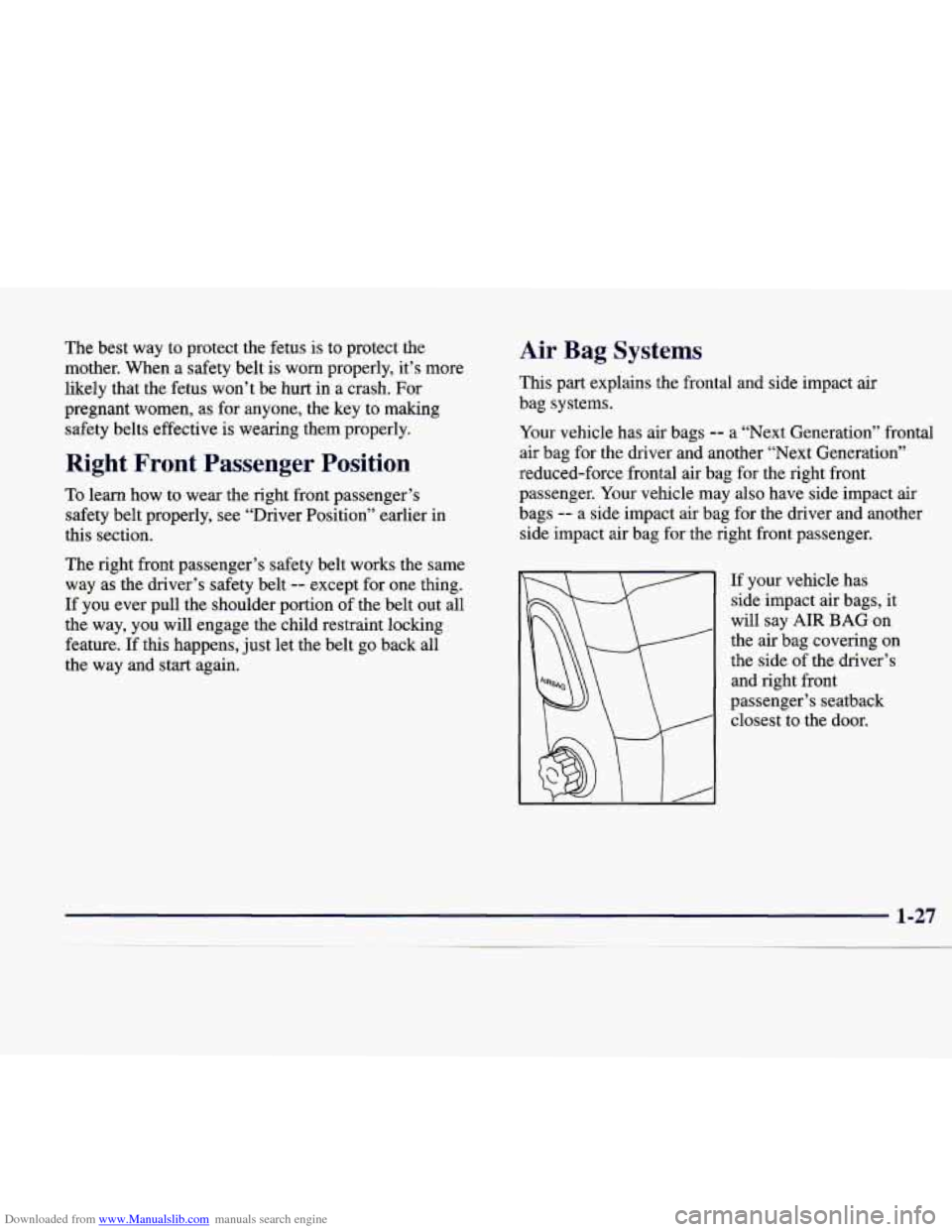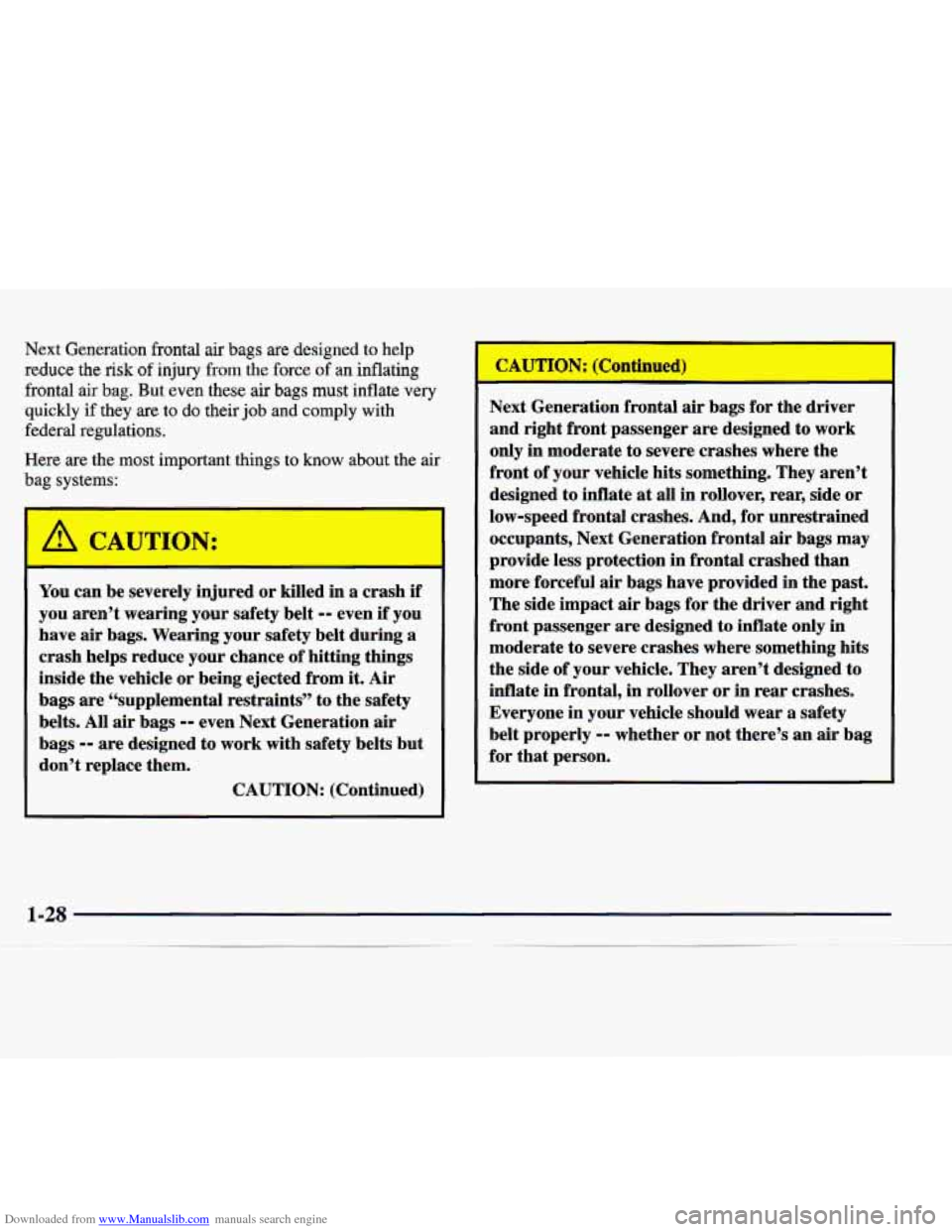Page 36 of 346
Downloaded from www.Manualslib.com manuals search engine @ What’s wrong with this?
A: The belt is buckled in the wrong place.
-
You can be seriously injured if your belt is
buckled in the wrong place like this. In a crash,
the belt would
go up over your abdomen. The
belt forces would
be there, not at the pelvic
bones. This could cause serious internal injuries.
Always buckle your belt into the buckle
nearest you.
Page 37 of 346
Downloaded from www.Manualslib.com manuals search engine @' What's wrong with this?
A: The shoulder belt is worn under the arm. It should
be worn over the shoulder at all times.
A CAUT-3N:
I
You can be seriously injured if you wear the
shoulder belt under your arm. In
a crash, your
body would move
too far forward, which would
increase the chance of head and neck injury.
Also, the belt would apply too much force to the
ribs, which aren't
as strong as shoulder bones.
You could also severely injure internal organs
like your liver or spleen.
Page 38 of 346
Downloaded from www.Manualslib.com manuals search engine Q: What's wrong with this?
1 I f I I I I I I I 1 J
A: The belt is twisted across the body.
A CAUTION:
-
You can be seriously injured by a twisted belt. In
a crash, you wouldn't have the full width
of the
belt to spread impact forces. If a belt is twisted,
make it straight
so it can work properly, or ask
your dealer to fix it.
I I
Page 39 of 346
Downloaded from www.Manualslib.com manuals search engine To unlatch the belt, just push the button on the buckle.
The belt should
go back out of the way.
Before you close the door, be sure the belt is out of the
way. If you slam the door on it, you
can damage both the
belt and your vehicle.
Safety Belt Use During Pregnancy
Safety belts work for everyone, including pregnant
women. Like all occupants, they are more likely to be
seriously injured if they don’t wear safety belts.
A pregnant woman should wear a lap-shoulder belt, and
the lap portion should be worn as low as possible, below
the rounding, throughout the pregnancy.
Page 40 of 346

Downloaded from www.Manualslib.com manuals search engine The best way to protect the fetus is to protect the
mother. When a safety belt is worn properly, it’s more
likely that the fetus won’t be hurt in a crash. For
pregnant women, as for anyone, the key to making
safety belts effective is wearing them properly.
Right Front Passenger Position
To learn how to wear the right front passenger’s
safety belt properly, see “Driver Position” earlier in
this section.
The right front passenger’s safety belt works the same
way as the driver’s safety belt
-- except for one thing.
If you ever pull the shoulder portion of the belt out all
the way,
you will engage the child restraint locking
feature.
If this happens, just let the belt go back all
the way and start again.
Air Bag Systems
This part explains the frontal and side impact air
bag systems.
Your vehicle has air bags
-- a “Next Generation” frontal
air bag for the driver and another “Next Generation”
reduced-force frontal air bag for the right front
passenger. Your vehicle may also have side impact air
bags
-- a side impact air bag for the driver and another
side impact air bag for the right front passenger.
If your vehicle has
side impact
air bags, it
will say AIR BAG on
the air bag covering on
the side of the driver’s
and right front
passenger’s seatback closest to the door.
Page 41 of 346

Downloaded from www.Manualslib.com manuals search engine Next Generation frontal air bags are designed to help
reduce
the risk of injury from the force of an inflating
frontal air
bag. But even these air bags must inflate very
quickly if they are to do their
job and comply with
federal regulations.
Here are the most important things to know about the air
bag systems:
You can be severely injured or killed in a crash if
you aren’t wearing your safety belt
-- even if you
have air bags. Wearing your safety belt during a
crash helps reduce your chance of hitting things
inside the vehicle or being ejected from it.
Air
bags are ‘(supplemental restraints” to the safety
belts. All air bags
-- even Next Generation air
bags
-- are designed to work with safety belts but
don’t replace them.
CAUTION: (Continued) Next
Generation frontal
air bags for the driver
and right front passenger are designed to work
only in moderate to severe crashes where the
front of your vehicle hits something. They aren’t
designed to inflate at all in rollover,
rear, side or
low-speed frontal crashes. And, for unrestrained
occupants, Next Generation frontal air bags may
provide less protection in frontal crashed than
more forceful air bags have provided in the past.
The side impact air bags for the driver and right
front passenger are designed to inflate only in
moderate to severe crashes where something hits
the side of your vehicle. They aren’t designed to
inflate in frontal, in rollover or in rear crashes.
Everyone in your vehicle should wear a safety
belt properly
-- whether or not there’s an air bag
for that person.
Page 42 of 346

Downloaded from www.Manualslib.com manuals search engine I A CAUTION:
Both frontal and side impact air bags inflate with
great force, faster than the blink of an eye. If
you’re too close to an inflating air bag, it could
seriously injure you.
This is true even with Next
Generation frontal air bags. Safety belts help keep
you
in position for air bag inflation before and
during a crash. Always
wear your safety belt, even
with Next Generation frontal
air bags. The driver
should sit
as far back as possible while still
maintaining control of the vehicle. Front occupants
should not lean on or sleep against the door.
I
A C WTION:
I
Children who are up against, or very close to, any
air bag when it inflates can be seriously injured
or killed. This is true even though your vehicle
has Next Generation frontal air bags. Air bags
plus lap-shoulder belts offer the best protection
for adults, but not for young children and
infants. Neither the vehicle’s safety belt system
nor its air bag system is designed for them.
Young children and infants need the protection
that
a child restraint system can provide. Always
secure children properly in your vehicle.
To read
how, see the part of this manual called
“Children” and see the caution labels on the
sunvisors and the right front passenger’s
safety belt.
Page 46 of 346

Downloaded from www.Manualslib.com manuals search engine The driver’s and right front passenger’s side impact air
bags are designed to inflate in moderate to severe side
crashes involving a front door.
A side impact air bag
will inflate if the crash severity is above the system’s
designed “threshold level.” The threshold
level can
vary with specific vehicle design. Side impact air bags
are not designed to inflate in frontal or near-frontal
impacts, rollovers or rear impacts, because inflation
would not help the occupant.
A side impact air bag will
only deploy on the side of the vehicle that is struck.
In any particular crash, no one can say whether an air
bag should have inflated simply because of the damage
to a vehicle or because of what the repair costs were.
For frontal air bags, inflation is determined by the angle
of the impact and how quickly the vehicle slows down
in frontal and near-frontal impacts. For side impact air
bags, inflation is determined by the location of the
impact and how quickly the side of the vehicle deforms.
What makes an air bag inflate?
In an impact of sufficient severity, the air bag sensing
system detects that the vehicle is in a crash. For both
frontal and side impact air bags, the sensing system
triggers a release of gas from the inflator, which inflates
the air bag. The inflator, air bag and related hardware
are all part of the air bag modules inside the steering
wheel, instrument panel and the side of the front
seatbacks closest to the door.
How does an air bag restrain?
In moderate to severe frontal or near frontal collisions,
even belted occupants can contact the steering wheel or
the instrument panel. In moderate to severe side
collisions, even belted occupants can contact the inside
of the vehicle. The air bag supplements the protection
provided by safety belts.
Air bags distribute the force of
the impact more evenly over the occupant’s upper body,
stopping the occupant more gradually. But the frontal air
bags would not help you in many types of collisions,
including rollovers, rear impacts, and side impacts,
primarily because an occupant’s motion is not toward
the air bag. Side impact air bags would not help you in
many types of collisions, including frontal or near
frontal collisions, rollovers, and rear impacts, primarily
because an occupant’s motion is not toward those air
bags. Air bags should never be regarded
as anything
more than a supplement to safety belts, and then only in
moderate
to severe frontal or near-frontal collisions for
the driver’s and right front passenger’s frontal air bags,
and only in moderate to severe side collisions for the
driver’s and right front passenger’s side impact air bags.